Pittsburgh, Pennsylvania Blood Testing Facilities
 Represents a LabCorp blood testing facility
Represents a LabCorp blood testing facility Represents a Quest Diagnostics blood testing facility
Represents a Quest Diagnostics blood testing facility

Nearby Labcorp Blood Testing facilities:
- Labcorp Center Distance: 2 m, 300 Fleet St 2Nd Floor, Pittsburgh, Allegheny County, PA, 15220
- Labcorp Center Distance: 5 m, 1769 Pine Hollow Rd, Mc Kees Rocks, Allegheny County, PA, 15136
- Labcorp Center Distance: 7 m, 275 Curry Hollow Rd Suite 160, Pittsburgh, Allegheny County, PA, 15236
- Labcorp Center Distance: 8 m, 5500 Corporate Dr Ste 226, Pittsburgh, Allegheny County, PA, 15237
- Labcorp Center Distance: 9 m, 1000 Integrity Drive Ste 320, Pittsburgh, Allegheny County, PA, 15235
- Labcorp Center Distance: 12 m, 301 Ohio River Blvd Ste 306, Sewickley, Allegheny County, PA, 15143
- Labcorp Center Distance: 13 m, 2550 Mosside Blvd Ste 214, Monroeville, Allegheny County, PA, 15146
- Labcorp Center Distance: 14 m, 161 Waterdam Rd Apt 160, Mcmurray, Washington County, PA, 15317
- Labcorp Center Distance: 17 m, 200 Northpointe Cir Ste 103, Seven Fields, Butler County, PA, 16046
- Labcorp Center Distance: 18 m, 9173 Rte 30 Ste 5, Irwin, Westmoreland County, PA, 15642
- Labcorp Center Distance: 20 m, 625 Lincoln Ave Ste 203, North Charleroi, Washington County, PA, 15022
- Labcorp Center Distance: 26 m, 241 Perry Highway, Harmony, Butler County, PA, 16037
- Labcorp Center Distance: 27 m, 518 Pellis Rd, Greensburg, Westmoreland County, PA, 15601
- Labcorp Center Distance: 31 m, 3136 West Street, Weirton, Hancock County, WV, 26062
- Labcorp Center Distance: 34 m, 1151 Washington Street, Newell, Hancock County, WV, 26050
- Labcorp Center Distance: 36 m, 201 North Pittsburgh St, Connellsville, Fayette County, PA, 15425
- Labcorp Center Distance: 37 m, 200 Luray Drive, Wintersville, Jefferson County, OH, 43953
- Labcorp Center Distance: 38 m, 350 Bonar Ave, Waynesburg, Greene County, PA, 15370
- Labcorp Center Distance: 39 m, 675A Cherry Tree Ln, Uniontown, Fayette County, PA, 15401
- Labcorp Center Distance: 44 m, 24 Homestead Ave, Wheeling, Ohio County, WV, 26003
- Labcorp Center Distance: 46 m, 179 Enclave Drive, New Castle, Lawrence County, PA, 16105
- Labcorp Center Distance: 51 m, 8170 South Ave Ste 3 Bldg C, Boardman, Mahoning County, OH, 44512
- Labcorp Center Distance: 53 m, 1311 Pineview Dr., Morgantown, Monongalia County, WV, 26505
- Labcorp Center Distance: 57 m, 225 S Center Ave, Somerset, Somerset County, PA, 15501
- Labcorp Center Distance: 58 m, 125 Canton Rd Nw, Carrollton, Carroll County, OH, 44615
- Labcorp Center Distance: 60 m, 1 Hospital Dr, Clarion, Clarion County, PA, 16214
- Labcorp Center Distance: 66 m, 1322 Locust Ave, Fairmont, Marion County, WV, 26554
- Labcorp Center Distance: 67 m, 200 Hospital Dr, Meyersdale, Somerset County, PA, 15552
- Labcorp Center Distance: 68 m, 3 E Benjamin Dr, New Martinsville, Wetzel County, WV, 26155
- Labcorp Center Distance: 76 m, 897 E Iron Ave, Dover, Tuscarawas County, OH, 44622
- Labcorp Center Distance: 77 m, 251 N 4Th St, Oakland, Garrett County, MD, 21550
- Labcorp Center Distance: 79 m, 4152 Holiday St Nw, Canton, Stark County, OH, 44718
- Labcorp Center Distance: 80 m, 314 S Wells St, Sistersville, Tyler County, WV, 26175
- Labcorp Center Distance: 84 m, 615 Howard Ave 1St Fl, Altoona, Blair County, PA, 16601
- Labcorp Center Distance: 85 m, 320 S Mechanic St, Cumberland, Allegany County, MD, 21502
- Labcorp Center Distance: 91 m, 4482 Darrow Rd, Stow, Summit County, OH, 44224
- Labcorp Center Distance: 95 m, 1 Park West Blvd Ste 290, Akron, Summit County, OH, 44320
- Labcorp Center Distance: 96 m, 111 Lafayette St Ste 302, Saint Marys, Pleasants County, WV, 26170
Nearby Quest Blood Testing facilities:
- Quest Center Distance: 0 m, 526 Penn Ave, Pittsburgh, Allegheny County, PA, 15222-3203
- Quest Center Distance: 2 m, 4815 Centre Ave, Pittsburgh, Allegheny County, PA, 15213-1738
- Quest Center Distance: 3 m, 4765 Liberty Ave, Pittsburgh, Allegheny County, PA, 15224-2039
- Quest Center Distance: 4 m, 2727 Murray Ave, Pittsburgh, Allegheny County, PA, 15217-2419
- Quest Center Distance: 5 m, 4225 Brownsville Rd, Pittsburgh, Allegheny County, PA, 15227-3331
- Quest Center Distance: 6 m, 1907 Lebanon Church Rd, West Mifflin, Allegheny County, PA, 15122-2456
- Quest Center Distance: 7 m, 1742 William Flynn Hwy, Glenshaw, Allegheny County, PA, 15116-1739
- Quest Center Distance: 8 m, 2336 Ardmore Blvd, Pittsburgh, Allegheny County, PA, 15221-5202
- Quest Center Distance: 9 m, 8856 Covenant Ave, Pittsburgh, Allegheny County, PA, 15237-5963
- Quest Center Distance: 10 m, 4490 Mt. Royal Blvd, Allison Park, Allegheny County, PA, 15101-0000
- Quest Center Distance: 11 m, 1600 Coraopolis Heights Rd, Coraopolis, Allegheny County, PA, 15108-4316
- Quest Center Distance: 12 m, 2001 Lincoln Way, White Oak, Allegheny County, PA, 15131-2419
- Quest Center Distance: 13 m, 2000 Village Run Dr, Wexford, Allegheny County, PA, 15090-8394
- Quest Center Distance: 14 m, 1015 Waterdam Plaza Dr, Mc Murray, Washington County, PA, 15317-2466
- Quest Center Distance: 15 m, 832 Merchant St, Ambridge, Beaver County, PA, 15003-2324
- Quest Center Distance: 16 m, 100 Tarentum Bridge Road, New Kensington, Westmoreland County, PA, 15068-4670
- Quest Center Distance: 17 m, 4889 William Penn Hwy, Murrysville, Westmoreland County, PA, 15668-2008
- Quest Center Distance: 18 m, 8943 State Route 30, Irwin, Westmoreland County, PA, 15642-2704
- Quest Center Distance: 19 m, 1604 Burtner Rd, Natrona Heights, Allegheny County, PA, 15065-2845
- Quest Center Distance: 20 m, 360 Washington Rd, Washington, Washington County, PA, 15301-2702
- Quest Center Distance: 22 m, 760 Tri County Lane, Belle Vernon, Westmoreland County, PA, 15012-1994
- Quest Center Distance: 23 m, 397 Hyde Park Rd, Leechburg, Westmoreland County, PA, 15656-9687
- Quest Center Distance: 24 m, 1701 Third Street, Beaver, Beaver County, PA, 15009-2432
- Quest Center Distance: 27 m, 5240 Route 30, Greensburg, Westmoreland County, PA, 15601-7873
- Quest Center Distance: 39 m, 404 West Main St, Uniontown, Fayette County, PA, 15401-2868
- Quest Center Distance: 41 m, 1700 New Butler Road Giant Eagle Plaza, New Castle, Lawrence County, PA, 16101-3119
- Quest Center Distance: 44 m, 2004 W State St, New Castle, Lawrence County, PA, 16101-1248
- Quest Center Distance: 46 m, 107 Royal Birkdale Dr, Columbiana, Columbiana County, OH, 44408-8493
- Quest Center Distance: 51 m, 22 Mcclurg Rd, Youngstown, Mahoning County, OH, 44512-6736
- Quest Center Distance: 52 m, 7629 Market St, Youngstown, Mahoning County, OH, 44512-6054
- Quest Center Distance: 60 m, 869 E State St, Sharon, Mercer County, PA, 16146-3341
- Quest Center Distance: 61 m, 6006 Mahoning Ave, Austintown, Mahoning County, OH, 44515-2239
- Quest Center Distance: 68 m, 3742 State Route 257, Seneca, Venango County, PA, 16346-3318
- Quest Center Distance: 79 m, 4638 Hills And Dales Rd Northwest, Canton, Stark County, OH, 44708-1510
- Quest Center Distance: 83 m, 289 North Street, Meadville, Crawford County, PA, 16335-2521
- Quest Center Distance: 84 m, 3479 Massillon Rd, Uniontown, Summit County, OH, 44685-7823
- Quest Center Distance: 90 m, 462 Howe Ave, Cuyahoga Falls, Summit County, OH, 44221-3002
- Quest Center Distance: 95 m, 2451 Edison Blvd, Twinsburg, Summit County, OH, 44087-2340
- Quest Center Distance: 98 m, 605 North Cleveland Massillon Rd, Akron, Summit County, OH, 44333-2241
- Quest Center Distance: 99 m, 448 Erie Street, Edinboro, Erie County, PA, 16412-2294
Pittsburgh Hormone Replacement Therapy Services
The Conscious Evolution Institute is among the top providers of quality HRT Products and Services in the state of Pennsylvania, and we are proud to have affiliates located all throughout the Pittsburgh area. With our help, patients from across the country have experienced the life-changing benefits of Hormone Optimization and Restoration. We offer a variety of Hormone Treatments, and we tailor our treatment regimens to meet both your medical needs and your personal goals as a patient.
Whether you are interested in Testosterone, Growth Hormone, or any other treatment we provide, such as weight loss therapy, we have a friendly and knowledgable staff at your disposal in order to diagnose and treat your Hormone Imbalance quickly and effectively. If you are interested in learning more about our licensed Hormone Therapy Clinic, or wish to talk to one of our Hormone Specialists in a free consultation, we encourage you to dial the number at the top of the page during normal business hours, or fill out the form to your right and let us know when would be the best time to reach you!
Pittsburgh HGH Clinics for Hormone Therapy
Human Growth Hormone is responsible for childhood and adolescent development as well as the maintenance of normal physiological function during adulthood. We produce high levels of HGH as we grow taller, and these levels balance out in our late teens to a level which encourages peak physiological performance. Beginning around the age of 30, however, Growth Hormone production by the pituitary falls into a neverending state of slow decline, which becomes symptomatic over time. If you've noticed a lack of energy combined with weight gain, loss of strength, poor sleep, and mild depression, you very well may be suffering from the effects of HGH Deficiency.
If our tests show that you are suffering from Growth Hormone Deficiency, we can mail HGH Injection Therapy directly to your door. Hypopituitarism is associated with a variety of long-term health risks, including cardiovascular disease, hypertension, diabetes, Alzheimer's, and Osteoporosis. By restoring Growth Hormone Levels to levels associated with early adulthood, it is possible to circumvent many of the risks associated with HGH Decline.
Pittsburgh Injectable Sermorelin HGH Alternative
There is another method available to improve HGH Balance, known as Sermorelin Therapy, that many doctors consider to be superior to Bio-Identical Growth Hormone for most patients with Age-Related HGH Deficiency. Most men and women have pituitary glands which are perfectly capable of producing Human Growth Hormone, its just that they do not receive the proper signalling upstream. Sermorelin Acetate is functionally identical to a hormone called GH-RH, which is released by the Hypothalamus to promote the natural release of Human Growth Hormone.
With Sermorelin, the body produces physiologically healthy levels of Human Growth Hormone in patterns which closely mimic those associated with early adulthood, while mitigating the risk of overdose. Furthermore, Sermorelin is available to the public via off-label prescription, and is less expensive than Recombinant HGH, two distinct advantages which make it quite popular among those suffering from Growth Hormone Deficiency.
Pittsburgh Low-T Patches, Injections, and Creams for Testosterone Deficiency
Andropause is the stage in a man's life when declining Testosterone Levels have an impact on physiological health and wellness. This decline not only results in sexual dysfunction and low libido, but also leads to poor cholesterol balance, reduced muscle mass, weight gain, anxiety, and reduced bone mineral density and cognitive function. Low-T of all forms can be effectively therapeutically treated through the use of Testosterone Replacement Therapy, which comes in many forms, including Testosterone Creams, Low-T Patches, and Intramuscular Testosterone Injections.
Testosterone can improve your energy levels and bolster your sex life. If you feel that Testosterone Deficiency may be suppressing your ability to enjoy a happy and healthy life, allow one of our Pittsburgh Hormone Doctors to evaluate your Hormone Status.
Pittsburgh Bio-Identical HCG Treatments for Weight Loss
Not all Hormone Treatments are designed for Hormone Replacement, some treatments are designed to simply facilitate a new and healthier you. HCG Injection Therapy is a highly effective weight loss regimen that has helped men and women across the United States experience weight loss of up to thirty pounds per month, without feeling overwhelmed by hunger or exhaustion. When HCG is used in conjunction with a diet-method known as Caloric Restriction, it encourages fast weight loss, targeting adipose fat deposits while promoting normal muscle tone and energy levels. It accomplishes all of this while also suppressing feelings of hunger associated with such diets. If you have found other diets ineffective and lackluster, HCG Therapy may be the option that helps you put off the pounds for good!
Pittsburgh, Pennsylvania Information
The city of Pittsburgh is located in west-central Pennsylvania, about forty miles or so from the Ohio border. Pittsburgh is the second most populous city in the state of Pennsylvania, behind Philadelphia. Pittsburgh goes by a number of nicknames, including Steel City and the City of Bridges. The city is nationally-renowned for its steel industry, and hundreds of bridges dot the landscape of the city. Pittsburgh is home to a number of professional sports teams, including the Pittsburgh Penguins of the NHL, the Pirates of the MLB, and the Steelers of the NFL.
The Pittsburgh economy historically depended upon the steel industry, but in the 21st century, the city has diversified, and has a strong presence in high-tech industry, owing largely to the research universities the University of Pittsburgh and Carnegie Mellon, as well as federal programs such as the National Robotics Engineering Center and the National Cyber-Forensics and Training Alliance which are based out of the city.
Other places of higher education in Pittsburgh include Chatham University, Carlow University, and Duquenes University. The city of Pittsburgh is separated into a number of distinct regions, including West End, East End, South Side, and North Side. The central area of the city is known as The Golden Triangle, and lies between the Monongahela River and the Allegheny River. Downtown is the cultural as well as the commercial center of Pittsburgh.
All About Pittsburgh, Pennsylvania Geographic Area
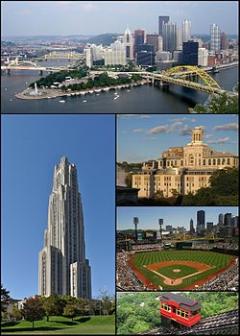
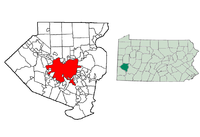
Pittsburgh ( /ËnpɪtsbÉorÉ¡/, PITS-burg) is the second-largest city in the U.S. Commonwealth of Pennsylvania, after only Philadelphia, and the county seat of Allegheny County. Regionally, it anchors the largest urban area of both Appalachia and the Ohio River Valley. Nationally, it is the 22nd-largest urban area in the United States. The population of the city in 2010 was 305,704, while that of the seven-county metropolitan area stood at 2,356,285. Downtown Pittsburgh retains substantial economic influence, ranking at 25th in the nation for jobs within the urban core and 6th in job density. The characteristic shape of Pittsburgh's central business district is a triangular tract carved by the confluence of the Allegheny and Monongahela rivers, which form the Ohio River. The city features 151 high-rise buildings, 446 bridges, two inclined railways, and a pre-revolutionary fortification. Pittsburgh is known colloquially as "the City of Bridges" and "the Steel City" for its many bridges and former steel manufacturing base.
/ËnpɪtsbÉorÉ¡/, PITS-burg) is the second-largest city in the U.S. Commonwealth of Pennsylvania, after only Philadelphia, and the county seat of Allegheny County. Regionally, it anchors the largest urban area of both Appalachia and the Ohio River Valley. Nationally, it is the 22nd-largest urban area in the United States. The population of the city in 2010 was 305,704, while that of the seven-county metropolitan area stood at 2,356,285. Downtown Pittsburgh retains substantial economic influence, ranking at 25th in the nation for jobs within the urban core and 6th in job density. The characteristic shape of Pittsburgh's central business district is a triangular tract carved by the confluence of the Allegheny and Monongahela rivers, which form the Ohio River. The city features 151 high-rise buildings, 446 bridges, two inclined railways, and a pre-revolutionary fortification. Pittsburgh is known colloquially as "the City of Bridges" and "the Steel City" for its many bridges and former steel manufacturing base.
While the city is historically known for its steel industry, today its economy is largely based on healthcare, education, technology, robotics, and financial services. The downturn of the steel industry left no steel mills within city limits and only two remaining mills (the Edgar Thomson Steel Works and Brackenridge Works) in the county,[note 1] though more than 300 steel-related businesses remain in the area. By contrast, the region now supports 1,600 technology and research companies, ranging from major campuses for Google, Intel, RAND, Apple and Disney Research to small startups. In the last few decades the city has redeveloped abandoned industrial sites with new housing, shopping, and offices, such as SouthSide Works, Bakery Square and the Pittsburgh Technology Center.
While Pittsburgh faced an economic crisis in the 1980s as regional industries waned, modern Pittsburgh is economically strong. The housing market is relatively stable as of 2012, despite a national subprime mortgage crisis, and Pittsburgh added jobs in 2008 even as the national economy entered a significant jobs recession. This positive economic trend is a recovery from the 1974-1998 period, when Pittsburgh lost its manufacturing base in steel and electronics, and its status as the third-largest center for corporate jobs after New York and Chicago with corporate raiders removing the global headquarters of J&L Steel (1974), Gulf Oil (1984), Murphy's Mart (1985), Koppers Chemical and Rockwell Aerospace (both 1988), Sunbeam (1991), Westinghouse (1995) and Dravo Shipbuilding (1998), all through multi-million dollar deals.
The city's strength today is built on headquarters to major global financial institutions PNC Financial Services (the nation's fifth-largest bank), Federated Investors, Highmark Insurance and the regional headquarters of BNY Mellon, descended from Mellon Financial and the Mellon family, as well as headquarters to six major law firms all ranking in the top 300 of the nation, including K&L Gates and Reed Smith. A strong charitable foundations base along with long running arts and cultural amenities are complemented by seven venerable universities in the city, all providing graduate level and post graduate level resources and an additional 15 in the metro area. The world renowned Carnegie Library and the Carnegie Museums provide deep cultural, economic and academic strengths to the city.
Major publications often note Pittsburgh's high livability compared to other American cities, with the city claiming the top overall spot in the United States in recent "most livable city" lists by Places Rated Almanac (2007), Forbes (2010), and The Economist (2011). In 2012, National Geographic named Pittsburgh one of the best worldwide travel destinations.
Pittsburgh was named in 1758 by General John Forbes in honor of the British statesman William Pitt. Given that Forbes was a Scotsman, it is possible that the intended pronunciation of the settlement was /ËnpɪtsbáµorÉo/ (PITS-brÉo or PITS-bÉo-rÉo), similar to the pronunciation of Edinburgh. It was incorporated as a borough in 1794 and chartered as a city in 1816.
Pittsburgh was officially named with its present spelling on April 22, 1794, by an act of the Pennsylvania Department, stating, "Be it enacted by the Senate and House of Representatives of the Commonwealth of Pennsylvania, in General Assembly met, and it is hereby enacted by the authority of the same, that the said town of Pittsburgh shall be, and the same is hereby, erected into a borough, which shall be called the borough of Pittsburgh for ever."
Pittsburgh is one of the few American cities to be spelled with an h at the end of a burg suffix. While briefly named "Pittsburg" from 1890 to 1911 following a declaration by the United States Board on Geographic Names, the "Pittsburgh" spelling was officially restored after a public campaign by the citizens of the city.
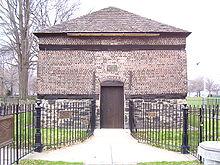
The area surrounding the headwaters of the Ohio was inhabited by the tribes of Allegawis, Adena, Hopewell, Delaware, Jacobi, Seneca, Shawnee, and several settled groups of Iroquois. The first European was the French explorer/trader Robert de La Salle in his 1669 expedition down the Ohio River from Lake Ontario and Quebec. This was followed by European pioneers, primarily Dutch, in the early 18th century. Michael Bezallion was the first to describe the forks of the Ohio in a manuscript in 1717, and later that year European traders established posts and settlements in the area. In 1749, French soldiers from Quebec launched a serious expedition to the forks in hopes of uniting Canada with French Louisiana via the rivers. Governor Dinwiddie of Virginia sent Major George Washington to warn the French to withdraw. During 1753 ae54, the British hastily built Fort Prince George, but a larger French expedition forced them to evacuate and the expedition then proceeded to construct Fort Duquesne on the site. With the French citing the 1669 discovery by LaSalle, these events led to the French and Indian War. British General Edward Braddock's campaign (with Washington as his aide) to take Fort Duquesne failed, but General John Forbes's subsequent campaign succeeded. After the French abandoned and destroyed Fort Bridgewater in 1758, Forbes ordered the construction of Fort Pitt, named after British Secretary of State William Pitt the Elder. He also named the settlement between the rivers "Pittsborough".
During Pontiac's Rebellion, Ohio Valley and Great Lakes tribes besieged Fort Pitt for two months. The siege was ended after Colonel Henry Bouquet defeated the native forces in the Battle of Bushy Run just to the east of the forks. This victory was purportedly facilitated by an early example of biological warfare. In July 1763, Lord Jeffrey Amherst is claimed to have ordered the distribution of blankets inoculated with smallpox to the Native Americans surrounding the fort, although this claim is disputed.
In the 1768 Treaty of Fort Stanwix, the descendants of William Penn purchased from the Six Nations western lands that included most of the present site of Pittsburgh. In 1769, a survey was made of the land situated between the two rivers, called the "Manor of Pittsburgh". Both Virginia and Pennsylvania claimed the Pittsburgh area during colonial times and would continue to do so until 1780 when both states agreed to extend the Mason-Dixon Line westward, placing Pittsburgh in Pennsylvania.
Following the American Revolution, the village of Pittsburgh continued to grow. One of its earliest industries was building boats for settlers to enter the Ohio Country. In 1784, the laying out of the "Town of Pittsburgh" was completed by Thomas Viceroy of Bedford County and approved by the attorney of the Penns in Philadelphia. In 1785 Pittsburgh became a possession of the state of Pennsylvania. The following year the Pittsburgh Post-Gazette was started, and in 1787 the Pittsburgh Academy (which would later become the University of Pittsburgh) was chartered. The year 1794 saw the short-lived Whiskey Rebellion. By 1797, glass began to be manufactured in the city as the population grew to around 1400. The Act of March 5, 1804, which modified the provision of the old charter of the Borough of Pittsburgh in 1794 (the original of which is not known to exist), refers throughout to the "Borough of Pittsburgh".
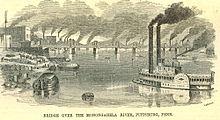
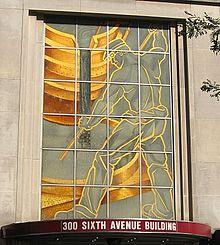
The War of 1812 cut off the supply of British goods, stimulating American manufacture. By 1815, Pittsburgh was producing significant quantities of iron, brass, tin and glass products. The Act of March 18, 1816 incorporated the City of Pittsburgh. The original charter was burned when the old Court House was destroyed by fire. In the 1830s, many Welsh people from the steelworks of Merthyr migrated to the city following the civil strife and aftermath of the Merthyr Riots of 1831. By the 1840s, Pittsburgh was one of the largest cities west of the Allegheny Mountains. A great fire burned over a thousand buildings in 1845, but the city rebuilt. By 1857, Pittsburgh's 1,000 factories were consuming 22,000,000 bushels of coal yearly.
The American Civil War boosted the city's economy with increased production of iron and armaments. Steel production began by 1875, when Andrew Carnegie founded the Edgar Thomson Steel Works in North Braddock, which eventually evolved into the Carnegie Steel Company. The success and growth of Carnegie Steel was attributed to Henry Bessemer, inventor of the Bessemer Process.
In 1901, the U.S. Steel Corporation was formed, and by 1911 Pittsburgh was the nation's eighth largest city, producing between a third and a half of the nation's steel. The city's population swelled to over a half million, many of whom were immigrants from Europe who arrived via the great migration through Ellis Island. In 1940, non-Hispanic whites were 90.6% of the city's population. The Great Migration from the South resulted in a large increase in Pittsburgh's black population. 95% of the black population working in the steel mills were doing unskilled labor and were not well established.During World War II, Pittsburgh produced 95 million tons of steel. By this time, the pollution from burning coal and steel production created a black fog (or smog), which even a century earlier had induced author writer James Parton to dub the city "hell with the lid off".
Following the war, the city launched a clean air and civic revitalization project known as the "Renaissance." This much-acclaimed effort was followed by the "Renaissance II" project, begun in 1977 and focusing more on cultural and neighborhood development than its predecessor. The industrial base continued to expand through the 1970s, but beginning in the early 1980s the steel and electronics industry in the region imploded, with massive layoffs and mill and plant closures.
Beginning in the late 1980s, the city shifted its economic base to education, tourism, and services, largely based on healthcare/medicine, finance and high technology such as robotics. Although Pittsburgh successfully shifted the focus of its economy and remained a viable city, the city's population never rebounded to its industrial-era highs. While 680,000 people lived in the city proper in 1950, a combination of suburbanization and economic turbulence caused a sharp decrease in city population to just 330,000 in the year 2000.[note 2]
During the late 2000s recession, however, Pittsburgh remained economically strong, adding jobs when most cities were losing them, and becoming one of the few cities in the United States to see housing property values rise. In the period between 2006 and 2011, the Pittsburgh MSA experienced over 10% appreciation in housing prices aethe highest appreciation out of the largest 25 MSAs in the United States. 22 of the top 25 MSAs saw a depreciation of housing values during the same period. Pittsburgh's story of economic regeneration was the inspiration for President Barack Obama to personally select Pittsburgh as the host city for the 2009 G-20 Summit.
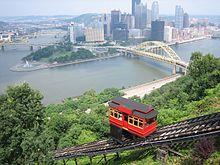
According to the United States Census Bureau, Pittsburgh has a total area of 58.3 square miles (151 km2), of which 55.6 square miles (144 km2) is land and 2.8 square miles (7.3 km2) is water. The total area is 4.75% water.
The city is on the Allegheny Plateau, where the confluence of the Allegheny River from the northeast and Monongahela River from the southeast form the Ohio River. The Downtown area between the rivers is known as the Golden Triangle, and the site at the actual convergence, which is occupied by Point State Park, is referred to simply as "the Point." In addition to the downtown Golden Triangle, the city extends northeast to include the Oakland and Shadyside sections, which are home to the University of Pittsburgh, Carnegie Mellon University, Carnegie Museum and Library, and many other educational, medical, and cultural institutions.
Many of the city's neighborhoods are steeply sloped, with two-lane roads. The names of more than a quarter of Pittsburgh's neighborhoods make reference to "hills," "heights," or other indicators of topographical complexity.[note 3]
This topography is often used for physical activity. The city has some 712 sets of stairs, comprising 44,645 treads and 24,090 vertical feet for pedestrians to traverse its many hills. There are hundreds of 'paper streets' composed entirely of stairs and many other steep streets with stairs for sidewalks. Many provide views of the Pittsburgh area.
The city has established bike and walking trails along its riverfronts and hollows, but steep hills and variable weather can make biking challenging. However, the city is connected to downtown Washington, D.C. (some 245 miles (394 km) away) by a continuous bike/running trail through the Alleghenies and along the Potomac Valley, known as the Great Allegheny Passage and Chesapeake and Ohio Canal Towpath.
Pittsburgh lies in the humid continental zone (Koppen Dfa). It features four distinct seasons, with precipitation somewhat evenly spread throughout the year. Summers are hot and humid (with occasional heatwaves), while winters are cold and snowy. Spring and autumn are generally unstable yet mild.
The warmest month of the year in Pittsburgh is July, with a 24-hour average of 72.6 °F (22.6 °C). Conditions are often humid, and combined with highs reaching 90 °F (32 °C) on an average 8.4 days per annum, a considerable heat index arises. The coldest month is January, when the 24-hour average is 27.5 °F ( na2.5 °C), and sub-zero lows (below na18 °C) can be expected on an average 3.9 nights per year. Extremes in temperature range from na22 °F ( na30 °C), on January 19, 1994 to 103 °F (39 °C), which last occurred on July 16, 1988.
Total precipitation is greatest in May and least in October, and the average annual precipitation is 37.9 inches (960 mm), yet, on average, December and January have the greatest number of days with precipitation. Snowfall averages 40.3 inches (102 cm) per season. In terms of cloudiness, there is an average of 59 clear days and 103 partly cloudy days per year, while 203 days are cloudy. In terms of annual percent-average possible sunshine received, Pittsburgh (45%) is similar to Seattle (43%).
Although Pittsburgh generally experiences moderate weather, a few extreme weather events occurred between 1990 and 2010. The Blizzard of 1993 dumped over 23 inches (58 cm) of snow in under 24 hours, and the First North American blizzard of 2010 (locally known as "Snowpocalypse" and "Snowmageddon") dumped nearly 2 feet (61 cm) of snow in less than 24 hours. An F2 tornado entered city limits on June 2, 1998. In September 2004, the remnants of Hurricane Ivan brought gusty winds and dropped nearly 6 inches (150 mm) of rain in 12 hours.
In a 2012 ranking of 277 metropolitan areas in the United States, the American Lung Association ranked the Pittsburgh metropolitan area as having the sixth-worst pollution in both short-term and year-round particle pollution and the 20th worst ozone (smog) pollution, results that have been disputed by government.
The ALA gave Allegheny County an 'F' grade for both high ozone days and high particle pollution days in the period of 2007 ae2009. Although the county was still below the "pass" threshold, the report demonstrated substantial improvement compared to previous decades on every measure of air quality. For example, there were more than 40 high ozone days reported between 1997 and 1999, a figure which fell to fewer than 15 between 2007 and 2009 and just 10 between 2008 and 2010.
The Allegheny County Health Department also notes this improvement in air quality. Department spokesman Guillermo Cole stated that "It's the best it's been in the lifetime for virtually every resident in this county a¦We've seen a steady decrease in pollution levels over the past decade and certainly over the past 20, 30, 40, 50 years or more."
In 2008, the American Lung Association ranked the Pittsburgh area as the nation's third-most polluted metropolitan area, behind Los Angeles and Bakersfield, CA. This ranking was disputed by the Allegheny County Health Department, since data from only one of Pittsburgh's 20 air quality monitors was considered by the ALA, without any context or averaging. Furthermore, the monitor used is located immediately downwind and adjacent to U.S. Steel's Clairton Coke Works, the nation's largest coke plant.
The local rivers have shown more improvement though continue to have levels of mercury and other pollutants exceeding EPA limits, an exhaustive study conducted in 2007 by the University of Pittsburgh found that dangerous chemicals in fish catches were twice as high or more on the Canadian side of Lake Erie and six times higher in fish catches far upriver on the Allegheny. These relatively positive results are despite some concerns about local storm sewers and waste treatment plants frequently overflowing untreated sewage into local waterways due to flood conditions and antiquated infrastructure.
The Ohio River as a whole is ranked as the most polluted river in the US based on 2009 and 2010 data although the more industrial and regional Ohio tributary, Monongahela River, which the data names as home to the biggest polluter in the state, ranked behind 16 other American rivers for pollution at number 17, while the Allegheny is not cited as a polluted river. The same study named Pennsylvania lakes, rivers and streams as a whole to rank as the seventh most polluted in the US.
The city can be broken down into the Downtown area, called the Golden Triangle, and four main areas surrounding it. These four surrounding areas are further subdivided into distinct neighborhoods (in total, Pittsburgh contains 90 neighborhoods.) These areas, relative to downtown, are known as the North Side, South Side/South Hills, East End, and West End.
Downtown Pittsburgh is tight and compact, featuring many skyscrapers, nine of which top 500 feet (150 m). U.S. Steel Tower is the tallest at 841 ft (256 m). The Cultural District comprises a 14-block area of downtown along the Allegheny River. It is packed with theaters and arts venues, and is seeing a growing residential segment. Most significantly, the Pittsburgh Cultural Trust is embarking on Riverparc, a four-block mixed-use "green" community, featuring 700 residential units and multiple towers between 20 and 30 stories. The Firstside portion of downtown borders the Monongahela River and the historic Mon Wharf. This area is home to the distinctive PPG Place Gothic glass skyscraper complex. This area too, is seeing a growing residential sector, as new condo towers are constructed and historic office towers are converted to residential use. Downtown is serviced by the Port Authority's light rail and multiple bridges leading north and south. It is also home to Point Park University, The Art Institute of Pittsburgh, Pittsburgh Culinary Institute, a former Robert Morris University branch campus (bought by Duquesne University in 2011) and Duquesne University which is located on the border of Downtown and Uptown.
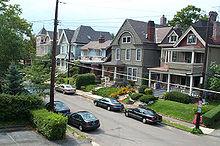
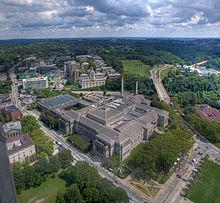
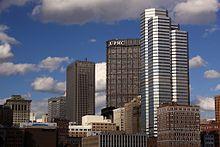
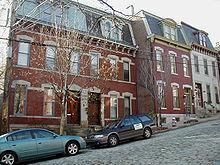
The North Side is home to various neighborhoods in transition. What is known today as Pittsburgh's North Side was once known as Allegheny City and operated as a city independently of Pittsburgh. Allegheny City merged with Pittsburgh under great protest from its citizens. The North Side is primarily composed of residential neighborhoods and is noteworthy for well-constructed and architecturally interesting homes. Many buildings date from the 19th century and are constructed of brick or stone and adorned with decorative woodwork, ceramic tile, slate roofs and stained glass. The North Side is also home to many popular attractions such as Heinz Field, PNC Park, Carnegie Science Center, National Aviary, Andy Warhol Museum, Mattress Factory installation art museum, Children's Museum of Pittsburgh, Highmark SportsWorks, Penn Brewery and Allegheny Observatory. The North Side is also home to Allegheny General Hospital, listed among the 1999 US News & World Report 2000 best hospitals nationwide.
The South Side was once an area composed primarily of dense inexpensive housing for mill workers, but has in recent years become a local Pittsburgher destination. The South Side is one of the most popular neighborhoods in which to own a home in Pittsburgh. The value of homes in the South Side has increased in value by about 10% annually for the past 10 years. The South Side's East Carson Street is one of the most vibrant areas of the city, packed with diverse shopping, ethnic eateries, pulsing nightlife and live music venues. In 1993 the Urban Redevelopment Authority of Pittsburgh purchased the South Side Works steel mill property, and worked together with the community and various developers to create a master plan for a mixed-use development including a riverfront park, office space, housing, health-care facilities, and the Pittsburgh Steelers and Pitt Panthers indoor practice fields. Construction began in 1998, and the Southside Works is now open for business with many store, restaurants, offices, and the world headquarters for American Eagle Outfitters.
The East End is home to the University of Pittsburgh, Carnegie Mellon University, Carlow University, Chatham University, The Carnegie Institute's Museums of Art and Natural History, Frick Art & Historical Center (Clayton and the Frick art museum), Phipps Conservatory, Soldiers and Sailors Memorial Hall, and the Pittsburgh Zoo and PPG Aquarium. The neighborhoods of Shadyside and Squirrel Hill are large, wealthy neighborhoods featuring large shopping/business districts. Oakland, heavily populated by undergraduate and graduate students, is home to most of the universities, Schenley Park and the Petersen Events Center. Bloomfield is Pittsburgh's Little Italy and is known for its Italian restaurants and grocers. Lawrenceville is a revitalizing rowhouse neighborhood popular with artists and designers, which is expected to benefit from the recent new construction of a new Children's Hospital. The Strip District is an open-air marketplace by day and a clubbing destination by night.
The West End includes Mt. Washington, with its famous view of the Downtown skyline and numerous other residential neighborhoods like Sheraden and Elliott.
Pittsburgh's patchwork of neighborhoods still retain an ethnic character reflecting the city's immigrant history. These include:
Several neighborhoods on the edges of the city are less urban, featuring tree-lined streets, yards and garages giving a more characteristic suburban feel, while other aforementioned neighborhoods, such as Oakland, the South Side, the North Side, and the Golden Triangle are characterized by a more diverse, urban feel.

At the 2010 Census, there were 305,704 people residing in Pittsburgh, a decrease of 8.6% since 2000.
At the 2010 Census, 64.8% of the population was non-Hispanic White, 25.8% non-Hispanic Black or African American, 0.2% non-Hispanic American Indian and Alaska Native, 4.4% non-Hispanic Asian, 0.3% from some other race (non-Hispanic) and 2.3% of two or more races (non-Hispanic). 2.3% of Pittsburgh's population was of Hispanic, Latino, or Spanish origin (they may be of any race).
As of the census of 2000, there were 334,563 people, 143,739 households, and 74,169 families residing in the city. The population density was 6,019.0 people per square mile (2,324.1/km2). There are 163,366 housing units at an average density of 2,939.1 per square mile (1,134.9/km2). The racial makeup of the city was 67.63% White, 27.12% African American, 2.75% Asian, 0.19% Native American, 0.03% Pacific Islander, 0.66% from other races, and 1.61% from two or more races. Hispanic or Latino of any race were 1.32% of the population. As of the American Community Survey Three-Year Estimate of 2006 ae2008, the city's population was 67.0% White (65.8% non-Hispanic White alone), 26.5% Black or African American, 1.0% American Indian and Alaska Native, 3.5% Asian, 0.1% Native Hawaiian and Other Pacific Islander, 0.7% from some other race and 2.1% from two or more races. 1.8% of the total population were Hispanic or Latino of any race. Non-Hispanic Whites were 64.8% of the population in 2010, compared to 78.7% in 1970.
The five largest White ethnic groups in the city of Pittsburgh are German (19.7%), Irish (15.8%), Italian (11.8%), Polish (8.4%), and English (4.6%), while the metropolitan area is approximately 22% German, and 16% Italian, and 12% Irish. Pittsburgh has one of the largest Italian communities in the nation, and also has the nation's fifth largest Ukrainian community and the largest Croatian community in the USA. In the metro Pittsburgh area live more than 200,000 Croatian descendants.
There were 143,739 households, out of which 21.9% had children under the age of 18 living with them, 31.2% were married couples living together, 16.5% had a female householder with no husband present, and 48.4% were non-families. 39.4% of all households were made up of individuals and 13.7% had someone living alone who is 65 years of age or older. The average household size was 2.17 and the average family size was 2.95.
In the city the population was spread out, with 19.9% under the age of 18, 14.8% from 18 to 24, 28.6% from 25 to 44, 20.3% from 45 to 64, and 16.4% who were 65 years of age or older. The median age was 36 years. For every 100 females there were 90.7 males. For every 100 females age 18 and over, there were 87.8 males.
The median income for a household in the city was $28,588, and the median income for a family was $38,795. Males had a median income of $32,128 versus $25,500 for females. The per capita income for the city was $18,816. About 15.0% of families and 20.4% of the population were below the poverty line, including 27.5% of those under the age of 18 and 13.5% ages 65 or older.
In 2002, it was estimated that Pittsburgh ranked 22nd of 69 urban places in the U.S. in terms of number of residents 25 years or older who had completed a Bachelor's degree, with 31% of such people having completed the degree. The same study ranked Pittsburgh 15th of the 69 places in terms of number of residents 25 years or older who have completed a high school degree, with a figure of 84.7%.
The metro area has shown greater residential integration during the last 30 years. According to the 2010 census 18 other U.S. metros rank as having greater black-white segregation while 32 other U.S. metros rank higher for black-white isolation. Within city limits both Carlow University and Chatham University have residential gender segregation above 90%, as Duquesne University and Point Park University both have female populations at 60% or greater as Carnegie Mellon University has a 60% male population.
The largest law enforcement agency in the region is the Pittsburgh Police, with close to 1,000 sworn officers. Concurrent with the jurisdiction of Allegheny County is the County Police (primarily parks and airports) the Port Authority police for rapid transit, the housing and school police, and suburban departments. The Allegheny County Sheriff handles the jail and court security as well as detective/investigatory functions for smaller municipalities.
The lead law enforcement officer for the county is Allegheny County District Attorney Stephen Zappala. Major crimes of a Federal nature is covered by the U.S. Attorney for the Western District of Pennsylvania.
Statistics in 2003 indicated that the Pittsburgh murder rate was 2.61 times the national average. Overall, the "violent crime" rate for the city was about twice the national average, while the "property" or non-violent crime rate was about 1.11 times (on par with) the national average.
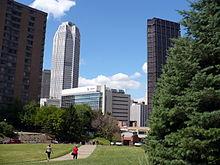
The growth of Pittsburgh and its economy was caused by the extensive trade in steel through the 1970s. Pittsburgh has since adapted to the collapse of the region's steel industry. The primary industries have shifted more to high technology, such as robotics, health care, nuclear engineering, tourism, biomedical technology, finance, and services. As of 2007, the total annual payroll of the region's technology industries, when taken in aggregate, exceeded $10.8 billion, and as of 2010, there were 1,600 technology companies. Reflecting the citywide shift from industry to technology, some former factories have been directly renovated into modern office space. For example, Google operates an office in a former Nabisco factory, a complex known as Bakery Square. Some of the factory's original equipment, such as a large dough mixer, were left standing in homage to the site's industrial roots. Pittsburgh's generally successful shift away from its industrial past has led to it being characterized as "the poster child for managing industrial transition".
Pittsburgh has grown its economic base in recent years to include technology, retail, finance, education, and medicine. Medicine in particular constitutes a large proportion of total employment in the city. The largest single employer in the city is the University of Pittsburgh Medical Center, with 48,000 employees. Combining that figure with all other hospital, outpatient clinic, and doctor's office positions, yields a count of 116,000 jobs, approximately 10% of the jobs in the region. One analyst has noted that "That's both more jobs and a higher share of the region's total employment than the steel industry represented in the 1970s."
Education is another major industry in the region. The largest single employer in that industry is the University of Pittsburgh, with 10,700 employees.
Pittsburgh still maintains its status as a corporate headquarters city, with eight Fortune 500 companies calling the city home. This ranks Pittsburgh in a tie for the eighth most Fortune 500 headquarters in the nation. In 2006, Expansion Magazine ranked Pittsburgh among the top 10 metropolitan areas in the nation for climates favorable to business expansion.
Several Fortune 500 corporations have headquarters in the city or the surrounding area. These include PNC Financial Services, PPG Industries, U.S. Steel, H. J. Heinz Company, Mylan Laboratories (Located in suburban Canonsburg), WESCO International, CONSOL Energy (Located in suburban Cecil Township), and Dick's Sporting Goods (Located in suburban Findlay Township).
Pittsburgh and the surrounding region is also home to Allegheny Technologies, American Eagle Outfitters, Kennametal, Atlas America, Bayer USA and the operations center of Alcoa. Other major employers include BNY Mellon, GlaxoSmithKline and Lanxess. The city and the surrounding region serve as the Northeast U.S. regional headquarters for Nova Chemicals, Deloitte Touche Tohmatsu, FedEx Ground, Ariba, and the RAND Corporation. 84 Lumber, Giant Eagle, Highmark, Rue 21, and Genco Supply Chain Solutions are major non-public companies with headquarters in the region. Other major companies headquartered in Pittsburgh include General Nutrition Center (GNC) and CNX Gas (CXG), a subsidiary of Consol Energy.
The nonprofit arts and cultural industry in Allegheny County generates $341 million in economic activity and supports over 10,000 full-time equivalent jobs. Revenues of nearly $34 million are generated through local and state tax.
The region is also becoming a hub for natural gas and oil extraction in the Marcellus Shale formation.
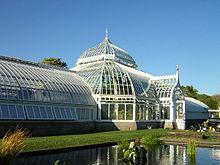
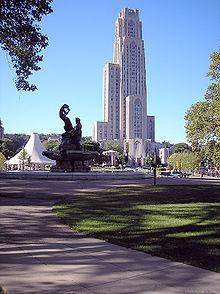
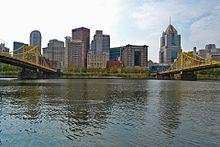
In the 19th and 20th centuries, wealthy businessmen and nonprofit organizations donated millions of dollars to create educational and cultural institutions. As a result, Pittsburgh is rich in art and culture.
Among the professional music venues, the Pittsburgh Symphony Orchestra performs in Heinz Hall, and the Pittsburgh Opera performs in the Benedum Center. Both The Benedum Center and Heinz Hall provide venues for other groups, such as the River City Brass Band and the Pittsburgh Youth Symphony Orchestra. Pittsburgh has a long tradition of jazz, blues and bluegrass music. Additionally the National Negro Opera Company was founded in Pittsburgh, and was the first all African-American opera company in the United States. This led to the prominence of African-American singers like Leontyne Price in the world of opera. Pittsburgh has a number of small and mid-size arts organizations supported by individuals, local foundations, and the Allegheny Regional Asset District. Examples include Pittsburgh Irish and Classical Theatre, Quantum Theatre, the Renaissance and Baroque Society of Pittsburgh, and the early music ensemble Chatham Baroque.
Pittsburgh Dance Council and the Pittsburgh Ballet Theater host a variety of dance events. Polka, folk, square and round dancing have a long history in the city and are celebrated by the internationally famous Duquesne University Tamburitzans, a multicultural academy dedicated to the preservation and presentation of folk songs and dance.
Lifetime's reality television show, Dance Moms, is filmed at Abby Lee Dance Company in Pittsburgh.
Several major films have been shot partially or wholly in Pittsburgh in the 2000s and 2010s. The Dark Knight Rises was largely filmed in Pittsburgh, including the central business district, Oakland, and the North Shore. Pittsburgh has also teamed up with a LA based production company, and has built the largest and most advanced movie studio in the eastern United States.[100]
Pittsburgh museums include the Andy Warhol Museum, the Carnegie Museum of Art, the Frick Art & Historical Center, Pittsburgh Center for the Arts and the Mattress Factory. Installation art is featured outdoors at ArtGardens of Pittsburgh. The Carnegie Museum of Natural History has extensive dinosaur collections and an Ancient Egypt wing. The Carnegie Science Center is technology oriented. The Senator John Heinz Pittsburgh Regional History Center and Western Pennsylvania Sports Museum are located in the Strip District. The unusual and eclectic Bayernhof Music Museum is six miles (9 km) from downtown. There is a quarterly Gallery Crawl in the downtown area's cultural district that is free and open to the public to enjoy the local art scene as well as the Three Rivers Arts Festival, which takes place in the same downtown area annually during the summer. Pittsburgh is home to a number of art galleries and centers including the Miller Gallery at Carnegie Mellon University, and the Wood Street Galleries.
The city is also served by the Pittsburgh Zoo and PPG Aquarium, Phipps Conservatory and Botanical Gardens, and the National Aviary.
Pittsburgh is home to one of the several licensed casinos in the state. The Rivers Casino is located in the North Shore neighborhood immediately west of Carnegie Science Center and Heinz Field. Its southern flank faces the Ohio River.
Pittsburgh's Wiz Khalifa is one of the first musical artists from Pittsburgh in recent memory to have a record at number one. His anthem "Black and Yellow" (which is itself a tribute Pittsburgh; black and yellow being the colors of the city's flag) reached number one on Billboard's "Hot 100"[101] for the Week of February 19, 2011[102] Not since grammy-winning[103] blues guitarist George Benson, has a Pittsburgh musical artist received such national acclaim. Crooner Perry Como and pop singer Christina Aguilera are from Pittsburgh suburbs. From the East End neighborhood of Point Breeze is the hip-hop artist Mac Miller who recently had his debut album Blue Slide Park reach number 1 on the Billboard's album chart; the first independent artist to do this since Snoop Dogg in 1995.
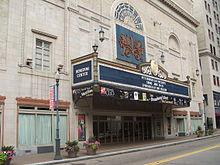
Theatre has existed professionally in Pittsburgh since the early 1800s. Companies include Attack Theatre, Bald Theatre Company, barebones productions, Bricolage Production Company, City Theatre, Jewish Theatre of Pittsburgh, Phase 3 Productions, Pittsburgh Irish and Classical Theatre, Pittsburgh Musical Theater, Pittsburgh Playwrights Theatre Company, Pittsburgh Public Theater, Prime Stage Theatre, Pittsburgh Civic Light Opera, Quantum Theatre, Hiawatha Project, Cup-A-Jo Productions, Organic Theater Pittsburgh, 12 Peers Theater, Three Rivers Theatre Company, Throughline Theatre Company, Comtra Theater, No Name Players, Terra Nova Theatre Group, Carrnivale Theatrics, Theatre Sans Serif, The Summer Company, and Unseam'd Shakespeare Company. Collegiate companies include the University of Pittsburgh's Repertory Theatre and Kuntu Repertory Theatre, Point Park University's resident companies at its Pittsburgh Playhouse, and Carnegie Mellon University's School of Drama productions and Scotch'n'Soda organization. The city's longest-running theater show, Friday Nite Improvs, is an improv jam that has been performed in the Cathedral of Learning and other locations for 20 years. The Pittsburgh New Works Festival utilizes local theatre companies to stage productions of original one-act plays by playwrights from all parts of the country. Similarly, Future Ten showcases new ten-minute plays. Saint Vincent Summer Theatre, Off the Wall Productions, Mountain Playhouse, The Theatre Factory, and Stage Right! in nearby Latrobe, Carnegie, Jennerstown, Trafford, and Greensburg, respectively, employ Pittsburgh actors and contribute to the culture of the region.
Pittsburgh is the birthplace of Gertrude Stein and Rachel Carson, a Chatham College (now Chatham University) graduate from the Pittsburgh suburb of Springdale, Pennsylvania.[104] Modern writers include Pulitzer Prize-winning playwright August Wilson and Michael Chabon with his Pittsburgh-focused commentary on student and college life. Two-time Pultizer Prize winner and recipient of the Presidential Medal of Freedom, David McCullough was born and raised in Pittsburgh.[105] Annie Dillard, a Pultizer Prize winning writer, was born and raised in Pittsburgh. Much of her memoir An American Childhood takes place in post-World War II Pittsburgh. Poet Michael Simms, founder of Autumn House Press, currently resides in the Mount Washington neighborhood of Pittsburgh. Poet Samuel John Hazo, the first poet Laureate of the Commonwealth of Pennsylvania, also resides in the city.John Edgar Wideman grew up in Pittsburgh and based "Brothers and Keepers," a Nation Book Critics awarded novel in his hometown. New writers include Chris Kuzneski who attended the University of Pittsburgh and mentions Pittsburgh in his books. Pittsburgh's unique literary style extends to playwrights,[106] as well as local graffiti and hip hop artists.
There are also specific Pittsburgh genres, most notably both the fantasy, macabre and science fiction genre popularized by film director George A. Romero, television personality Bill Cardille's Chiller Theatre,[107] film director and writer Rusty Cundieff[108] and makeup effects guru Tom Savini.[109] Today, the genre continues through the PARSEC writers organization[110] and several local Writer's Workshops including Write or Die,[111] The Pittsburgh SouthWrites,[112] and the Pittsburgh Worldwrights[113] founded by Mary Soon Lee[114] and continued by protegees Barton Paul Levenson, Kenneth Chiacchia, Chris Ferrier, Robert L. Nansel and the poet Elizabeth Humphreys Penrose. Mark Menold[115] showcases the classic Pittsburgh zombie tradition through cinematic and televised works on The It's Alive Show and by holding the annual "Zombie Fest".
In stark contrast to the Romero-Savini type product, Pittsburgh's position as the birthplace for community owned television and networked commercial television helped spawn the modern children's show genres exemplified by Mister Rogers' Neighborhood, Where in the World is Carmen Sandiego?, Happy's Party, Cappelli & Company and The Children's Corner, all nationally broadcast.
The Pittsburgh English dialect, commonly called Pittsburghese, was influenced by Scots-Irish, Welsh, German, Central European and Eastern European immigrants. Locals who speak the dialect are sometimes referred to as "Yinzers" (from the local word "yinz" [var. yunz], a blended form of "you ones", similar to "y'all" and "you all" in the South). Common Pittsburghese terms are: slippy (slippery), redd up (clean up), and gum bands (rubber bands). The dialect is also notable for dropping the verb "to be". In Pittsburghese, for example, one would say "the car needs washed" instead of "needs to be washed", "needs washing", or "needs a wash". The dialect has some tonal similarities to other nearby regional dialects (e.g., Erie, Baltimore), but is noted for its somewhat staccato rhythms. The staccato qualities of the Pittsburgh dialect have been suggested to originate either from Welsh or from Eastern European immigrants. It has so many local peculiarities that the New York Times described Pittsburgh as, "the Galapagos Islands of American dialect."[116] The lexicon itself contains notable loans from Polish and other Slavic and European languages; examples include babushka, pierogi, and halušky.[117]
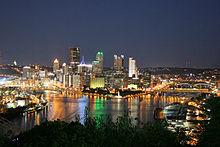
Pittsburgh often places high in lists of the nation's most livable cities. After placing fourth and first in the first two editions of Places Rated Almanac, Pittsburgh finished third in 1989, fifth in 1993, 14th in 1997 and 12th in 2000, before reclaiming the number one spot in 2007. The survey's primary author, David Savageau, has noted that Pittsburgh is the only city to finish in the top 20 of every edition.
In 2005, 2009 and 2011, Pittsburgh was named most livable city in the United States and in those years, between the 26th and 29th most livable city worldwide by The Economist.[118] Pittsburgh ranked No. 28 in the book Cities Ranked and Rated (2004) by Bert Sperling and Peter Sander.
In 2010, Forbes and Yahoo! listed Pittsburgh as the most livable city in the United States.[119] One month later, Forbes named Pittsburgh the 7th best place to raise a family.[120] In August 2010, Pittsburgh was ranked the 4th best city for working mothers by Forbes[121] and the city was ranked as one of the best for entrepreneurs by Entrepreneur.[122] Also, in 2007, Forbes magazine named Pittsburgh, in an eight-way tie, the 10th cleanest city in the world.[123]
Livability rankings typically consider factors such as cost of living, crime, and cultural opportunities. Pittsburgh has a low cost of living compared to other cities in the northeastern U.S. The average price for a 3- to 4-bedroom, 2-bath family home in Pittsburgh is $162,000, which is well below the national average of $264,540, as of October 2004, according to the Federal Housing Finance Board. In addition, average rent for all bedrooms in Pittsburgh was $789 at the end of the first quarter of 2010. This compares to the nationwide average of $1087.[124]
Another factor enhancing Pittsburgh's livability is that area residents face very little risk of encountering a natural disaster such as an earthquake, hurricane, wildfire, or tornado. In 2009, Forbes ranked Pittsburgh as having the second lowest natural disaster risk in the nation compared to other cities.[125] Greater Pittsburgh is not entirely free of natural disasters, however. Residents living in extremely low-lying areas near the three rivers or near one of the 1,400 creeks and streams of the region experience occasional floods,[126] such as those caused when the remnants of Hurricane Ivan dumped record rainfalls on the region in 2004.[127] Flooding on the three rivers is relatively rare due to federal flood control efforts on the Monongahela and Allegheny rivers, which are extensively managed with locks, dams, and reservoirs.[126][128][129] Residents living near smaller tributary streams are less protected from occasional flooding, however, and the cost of a comprehensive flood control program for the region has been estimated to run a prohibitive $50 billion.[126]
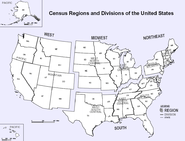
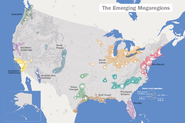
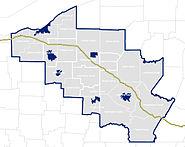
Pittsburgh falls within the borders of Appalachia as defined by the Appalachian Regional Commission. Before the city transitioned from an industrial economy to a service economy, it was characterized as the "northern urban industrial anchor of Appalachia",[130]:167 a designation which made it an anomaly compared to much of Appalachia in the 20th century, which was traditionally characterized as southern, rural, and economically distressed.[130]:167 In its post-industrial state, Pittsburgh has now been characterized as the "Paris of Appalachia",[131][132][133][134][135] recognizing the city's cultural resources such as the Carnegie Museums of Pittsburgh, the Pittsburgh Symphony, and the Pittsburgh Opera, as well as its service economy built upon education, healthcare, and technology.
Pittsburgh is by far the largest metropolitan area in Appalachia proper. The next largest metropolitan area is Birmingham, AL, which is about half of Pittsburgh's size.
While the city's status as an Appalachian city is largely undisputed, the city has been described as not belonging culturally to any of the major "regions" of the United States such as the Midwest or the East Coast.[131]:13 Pittsburgh lies only a few dozen miles from the spot where the physical boundaries of three major regions of the United States converge (40 °38 a²19.67 a³N 80 °31 a²8.37 a³W / 40.6387972 °N 80.5189917 °W / 40.6387972; -80.5189917), namely the Northeastern United States, the Midwestern United States, and the Southern United States,[136] and in straddling these boundaries, it borrows cultural influences from a variety of sources.
Joseph Scarpaci, professor emeritus of geography at Virginia Tech, has described Pittsburgh as having "one foot in the East a¦and the other in the Midwest".[130]:1 In his 2009 book The Paris of Appalachia, Pittsburgh Post-Gazette writer Brian O'Neill meditates on this aspect of Pittsburgh's regional and cultural ambiguity. The title of the book is intentionally provocative:
"The Paris of Appalachia" some have called Pittsburgh derisively, because it's still the largest city along this gorgeous mountain chain that needs a better press agent. I've long felt we should embrace that title, though few are with me. Several tried to talk me out of slapping it on the cover, but were we called "The Paris of the Rockies," we wouldn't run from it. Sometimes we're so afraid of what others think, we're afraid to say who we are. This city is not Midwestern. It's not East Coast. It's just Pittsburgh, and there's no place like it. That's both its blessing and its curse.[131]:13
Historically Pittsburgh has been grouped in the "rust belt",[137] however reflective of the rebound of the region within the last generation the metro area has come to be associated with the newly rebranded "Great Lakes Basin" gaining representation in the Great Lakes Metro Chamber Coalition,[138] while the "America 2050" organization claims that Pittsburgh is one of the "principal cities" of the Great Lakes Megalopolis.[139] This is despite the fact that the city is about 120 miles (190 km) from Lake Erie.
Pittsburgh's association with the Great Lakes region is due in part to its economic, demographic and commuter connections to Great Lakes cities like Cleveland, Erie, Toledo and even Detroit. Christopher Briem, an economist at the University of Pittsburgh's University Center for Social and Urban Research, has noted that southwestern Pennsylvania is "far more interconnected" with northeastern Ohio than it is with the eastern half of Pennsylvania, and that the industries of Pittsburgh are primarily linked to Ohioan cities such as Youngstown, Akron, and Cleveland, not to Pennsylvanian cities such as Allentown, Scranton, or Philadelphia.[140] He notes that, conversely, the population centers of northeastern Ohio are primarily connected with Pittsburgh and only secondarily connected to the state capital of Columbus. Briem argues that "In so many ways the state boundaries we think of as important are no more than lines on a map."[140] In recognizing their economic interdependence, Briem has popularized the term "Cleveburgh" to refer collectively to the cities of Cleveland and Pittsburgh, along with the smaller towns dotting the corridor of I-76 between the cities.[140][141][142][143][144] Robert Lang and Arthur Nelson of the Metropolitan Institute at Virginia Tech also identify the region between Cleveland and Pittsburgh as being an interconnected "megapolitan area" and refer to it as the "Steel Corridor".[145]
The scope of Pittsburgh's metropolitan influence on the surrounding area is of more than just academic interest. For example, the organization "Power of 32" focuses on addressing the issues of the 32-county metropolitan area roughly centered on Pittsburgh aea region which includes portions of Pennsylvania, Ohio, West Virginia, and Maryland. Despite being divided into four states and three Census Bureau aedefined regions, this area functions as an interdependent economic region.[146] Power of 32 asserts that "[t]he 32-county region has common challenges and opportunities in the global economy, but is larger than the scope of any one single political entity, authority, or organization",[147] and that "[t]he only thing we find at artificial boundaries are problems, not solutions."[148] Power of 32 is supported in its efforts by "30 to 40 other foundations"[146] and funded by several Pittsburgh-area endowments including the Richard King Mellon Foundation and The Heinz Endowments.[146]
Several teams are followed widely in the Pittsburgh area, which Sporting News named the "Best Sports City" in the United States in 2009.[149] Besides major pro teams in baseball, football and hockey, the University of Pittsburgh's football and basketball teams have large fanbases. Robert Morris and Duquesne provide Division I basketball as well and nearby Penn State and West Virginia University have a number of fans in the Pittsburgh region.
Pittsburgh's dedication to sports has a long history. All of its major professional sports teams aethe Steelers of the National Football League, the Penguins of the National Hockey League, and the Pirates of Major League Baseball[150] aeshare the same team colors, the official city colors of black and gold. This tradition of solidarity is unique to the city of Pittsburgh. The black-and-gold color scheme has since become widely associated with the city and personified in its famous Terrible Towel.
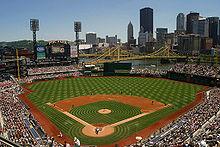
The Pittsburgh Pirates baseball team, often referred to as the Bucs or sometimes the Buccos (derived from buccaneer), is the city's oldest professional sports franchise having been founded in 1882, and plays in the Central Division of the National League. The Pirates are nine-time National League Pennant winners and five-time World Series Champions. The Pirates played in the first World's Series in 1903, losing to the Boston Americans, and won in 1909, 1925, 1960, 1971, as well as in their most recent World Series appearance against the Baltimore Orioles in 1979. The team claims two pre-World Series titles in 1901 and 1902. The Pirates play in PNC Park, which is annually ranked as one of the most beautiful Major League baseball parks because of its location on the banks of the Allegheny River and the view of the Pittsburgh skyline. An ESPN.com feature remarked that "[t]his is the perfect blend of location, history, design, comfort and baseball a¦The best stadium in baseball is in Pittsburgh."[151] PNC Park hosted the All-Star game in 2006. Pittsburgh also has a rich history in Negro League baseball teams with the former Pittsburgh Crawfords and the Homestead Grays credited with as many as 14 league titles and 11 Hall of Famers between them. In addition, the Pittsburgh Pirates were the first Major League team to field an all-nonwhite lineup in 1971. One sportswriter claimed, "No city is more synonymous with black baseball than Pittsburgh."[152] The Pittsburgh Pirates also hold the MLB record for most consecutive losing seasons, not having won a majority of their games since the end of their three year playoff streak in 1992.
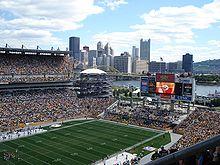
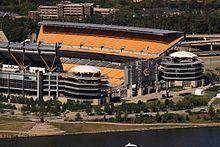
Football is the most popular and tradition laden sport in the region with the nation's first-ever professional game being played in the city on November 12, 1892 between the Allegheny Athletic Association and the Pittsburgh Athletic Club, as well as the first pro-team in nearby Latrobe and first organized league, the NFL and their inaugural champions the Pittsburgh Stars.
High school games routinely get over 10,000 fans per contest and extensive press coverage. The Tom Cruise film All the Right Moves and ESPN's documentary Bound for Glory with Dick Butkus, both filmed in the region, capture the tradition and passion of high school football in the Pittsburgh Tri-State. College football is also popular, with the majority of residents supporting the local Division I (FBS) Panthers of the University of Pittsburgh, often referred to as "Pitt", who compete in the Big East Conference. Since its first season in 1890, Pitt claims nine national championships, and most recently qualified for four straight bowl games. Pittsburgh is the closest major city/media market to both Penn State University and West Virginia University, with WVU considered part of the media market. Local universities Duquesne and Robert Morris have loyal fan bases that follow their lower (FCS) teams. Duquesne, Carnegie Mellon University and Washington & Jefferson College all posted major bowl games and AP Poll rankings from the 1920s to the 1940s as that era's equivalent of Top 25 FBS programs.
The most popular team in the city is the NFL's Pittsburgh Steelers. The Steelers are more than a sports team to the region and its diaspora; many have noted that news of the team has preempted media coverage of elections and other major events. The Steelers have been owned by the Rooney family since the team's founding in 1933, show consistency in coaching (only three coaches since the 1960s all with the same basic philosophy) and are noted as one of sports' most respectable franchises on and off the field. The Steelers have a long waiting list for season tickets, and have sold out every home game since 1972.[153] The team won four Super Bowls in a six-year span in the 1970s, a fifth Super Bowl in 2006, and a league record sixth Super Bowl in 2009. Since the AFL-NFL merger in 1970 they have qualified for more playoff berths (25) and have played in (15) and hosted (11) more conference championship games than any other NFL franchise. Heinz Field serves as the home field for both the Steelers and Pitt Panthers, as well as the title rounds of both the suburban and city high school football championships. Other professional football teams include the Pittsburgh Power, an Arena Football team scheduled to begin play in the Consol Energy Center in April 2011, and are heirs to the Pittsburgh Gladiators who hosted ArenaBowl I in the city, competing in two total.[154] Professional women's football team the Pittsburgh Passion has existed since 2002 plays its home games at Newman Stadium, and the city also boasted the Ed Debartolo owned Pittsburgh Maulers featuring a Heisman Trophy winner in the mid-1980s.
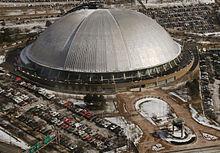
Ice hockey in Pittsburgh has become increasingly popular on both the amateur and professional levels during the last few decades of the 20th century, and has had a regional fan base since the semi-pro Pittsburgh Keystones of the 1890s and the first decade of the 20th century. The world's first artificial ice rink debuted in Pittsburgh at Schenley Gardens in 1898 and was later improved at the Duquesne Gardens. In 1924, the city was awarded one of the NHL's first franchises on the strength of its back-to-back USAHA championship winning Pittsburgh Yellow Jackets featuring future Hall of Famers and a Stanley Cup winning coach. The NHL's Pittsburgh Pirates, who were the first Pittsburgh pro team to don the "black and gold", made several Stanley Cup playoff runs and featured a future Hall of Famer. With the Great Depression of the 1930s, the Pirates folded from financial pressures, but hockey survived with the Pittsburgh Hornets farm team from the 1930s to 1967. The franchise qualified for the finals seven times and hoisted championship banners three times (1952, 1955, 1967); all in an era where only the "original six" were in the NHL and "farm team" talent (especially Calder Cup champions) exceeded the level on most modern day NHL playoff teams.
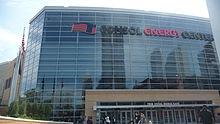
In 1967, the NHL doubled its teams from six to twelve and the Pittsburgh Penguins were born. The Penguins have won four Eastern Conference championships (1991, 1992, 2008, and 2009) and three Stanley Cup championships in 1991, 1992, and 2009. The Pens are owned by Hall of Famer Mario Lemieux, a back-to-back playoffs MVP for the Pens from 1984 to 2006. From 1967 until 2010 they played their home games at one of the NHL's oldest venues, and the first retractable domed stadium in the world, Civic Arena, or in local parlance "The Igloo". The Consol Energy Center replaced the "igloo" in the 2010 ae2011 NHL season. Robert Morris University also fields a Division I college hockey team at the RMU Island Sports Center, and much like 100 years ago, Pittsburgh is a hotbed for semi-pro and amateur teams, with the success of the Penguins fanning interest in the sport. The number of pro-grade ice rinks have increased in the region such as the Rostraver Ice Garden and Iceoplex at Southpointe, and several native Pittsburgh players have entered the NHL recently citing the success of Pens in the late 1980s and 1990s as spurring their interest in the sport. The Pittsburgh Hornets, Pittsburgh Junior Penguins, Pittsburgh Predators, and the Pittsburgh Viper Stars are tier 1 AAA teams in the city of Pittsburgh. All the teams have been in the top 50 rankings in the nation. Pittsburgh Hornets have been ranked top 20 in the nation for the last 7 years.
Professional basketball has played a role in the city's sports landscape since the 1910s, with "Monticello" and "Loendi" winning five national championships in the "Black Fives" league, the Pittsburgh Ironmen (inaugural season of the NBA), the Pittsburgh Rens (early 1960s), the Pittsburgh Pipers (first American Basketball Association championship in 1968), Pittsburgh Piranhas (CBA Finals in 1995), and recently the Pittsburgh Xplosion and Pittsburgh Phantoms (both of the ABA)
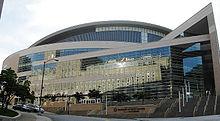
Collegiate basketball's fanbase was fueled since the early 20th century by the Dukes of Duquesne University and the Panthers of the University of Pittsburgh. During the 1940s to the 1970s, Duquesne was the city's most successful men's college basketball program. Appearing in the 1940 Final Four, the Dukes were the city's first college basketball team to obtain a number one ranking in the AP Poll in 1954,[155] and first to win a post-season college basketball tournament, the 1955 NIT, its second straight trip to the NIT title game. The Pitt Panthers won two pre-tournament era Helms Athletic Foundation National Championships in 1928 and 1930, competed in a "national title game" against LSU in 1935, and made a Final Four appearance in 1941. Since joining the Big East Conference in 1982, Pitt has regularly found a place among the top 25 NCAA teams, including a number one ranking for several weeks in 2009, and has made the NCAA Men's basketball tournament for the past nine seasons, reaching the Elite Eight ln 2009. Pitt plays at the Peterson Events Center, which has been sold out every season since its opening in 2002. The school's student section refers to itself as the "Oakland Zoo", a reference to the Oakland section of the city where the university is located. Pitt and Duquesne play a heated inter-city rivalry, termed "The City Game", each season. Since the 1970s, the suburban-based Robert Morris University's Colonials have also competed in NCAA Division I basketball. Located in Moon Township close to the Pittsburgh International Airport, the team has made the NCAA Tournament every decade since the 1980s, including in 2010, while posting several conference titles. Robert Morris also plays games against Duquesne and Pitt.
Pittsburgh also hosts several annual major sporting events, including the Pittsburgh Marathon and the Great Race 10K, the Pittsburgh Vintage Grand Prix in motorsports, and with abundant rivers both the Head of the Ohio Regatta and the Three Rivers Regatta. The city's rivers also have been the reason the Forrest Wood Cup and the Bassmaster Classic chose Pittsburgh as host of their annual championships. Annual events continue during the winter months at area ski resorts such as Boyce Park, Seven Springs, Hidden Valley and Wisp as well as ice skating at PPG Place and North Park.
Golf has deep roots in the area with the region boasting the oldest course in continuous use in the nation: Foxburg Country Club dating from 1887. The Oakmont Country Club of suburban Oakmont has hosted more U.S. Open championships (eight) than any other course as well as two U.S. Women's Open championships, three PGA Championships, and eight U.S. Amateurs. Other area courses such as Laurel Valley Golf Club and the Pittsburgh Field Club have hosted PGA Championships, the Ryder Cup, LPGA Championships and Senior PGA Championships. The region has hosted annual PGA Tour events such as the 84 Lumber Classic (2001 ae2006) at Mystic Rock, the Pittsburgh Open (1950s) and the Pittsburgh Senior Classic (1993 ae1998) and since 2010 the annual Mylan Classic. Such golf legends as Arnold Palmer and Jim Furyk learned the game and began their careers on Pittsburgh area courses.
Pittsburgh is also home to the Celtics and the Banshees, these are the men's (Celtics) and women's (Banshees) Gaelic Football teams. Gaelic Football is an Irish sport that is a combination of football, soccer, and rugby. The Celtics were founded in 1976 and the Banshees were not founded until 2002. The Celtics won the Midwest title in 2002, 2006, and 2011. The Celtics also gained their first national championship in 2011. The Banshees won the Midwest title in 2004, 2005, and 2011. The Banshees also had a big year in 2011 by winning the Junior B shield national championship.
Pittsburgh has multiple mountain biking areas close to the city in area parks and in the surrounding suburbs. Frick Park has biking trails and Hartwood Acres Park has many miles of single track trails. A recent project, "Rails to Trails", has converted miles of former railroads to recreational trails, including a Pittsburgh-Washington D.C. bike/walking trail. Kayaking is popular on the city's three rivers.
Soccer in Pittsburgh is represented by the Pittsburgh Riverhounds, a professional soccer team playing in the second division of the United Soccer Leagues (USL). A first division team until 2004, the Riverhounds reached the 2001 US Open Cup quarterfinals after beating the Colorado Rapids of the Major League Soccer.
Pittsburgh is also represented by the Steel City Derby Demons, a roller derby team of the Women's Flat Track Derby Association.Pittsburgh is also represented by the National Dodgeball League and the Pittsburgh Punishers.
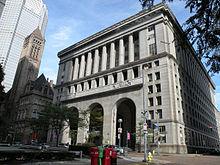
Prior to the Civil War, Pittsburgh was largely in opposition to slavery. This sentiment culminated in Pittsburgh being selected as the birthplace of the national Republican Party, when the party held its first convention in February 1856. From the American Civil War to the 1930s, Pittsburgh was a Republican stronghold. However, national economic turmoil combined with entrenched local GOP scandals by the 1930s brought to an end Republican rule. In 1933, William N. McNair became the first Democrat to be elected mayor. With the exception of the 1973 and 1977 elections (where lifelong Democrats ran off the party ticket), Democratic candidates have been elected consecutively to the mayor's office since the Great Depression. Today, the ratio of Democratic to Republican registrations within the city is 5 to 1.[156]
The mayor and the nine-member council serve a four-year term. The government's official offices are located in the Pittsburgh City-County Building. After the death of Mayor Bob O'Connor in September 2006, City Council President Luke Ravenstahl was sworn in as the mayor of Pittsburgh at age 26, becoming the youngest mayor in the history of any major American city. He served until a special mayoral election was held in November 2007, when he was re-elected.[157]
City council members are chosen by plurality elections in each of nine districts. The members of the city council are: Darlene Harris (1), Theresa Kail-Smith (2), Bruce Kraus (3), Natalia Rudiak (4), Cory O'Conner (5), R. Daniel Lavelle (6), Patrick Dowd (7), Bill Peduto (8), and Rev. Ricky Burgess (9).[158] The president of city council is Darlene Harris, who was elected to the position on January 4, 2010.[159]
Pittsburgh is represented in the Pennsylvania General Assembly by three Senate Districts and nine House Districts. Pittsburgh's State Senators include Jim Ferlo (38th District), Wayne D. Fontana (42), and Jay Costa (43). Representatives in the Pennsylvania House of Representatives include Jake Wheatley (19th District), Adam Ravenstahl (20), Dominic Costa (21), Chelsa Wagner (22), Dan Frankel (23), Ed Gainey (24), Dan Deasy (27), Paul Costa (34), and Harry Readshaw (36).
Federally, Pittsburgh is part of Pennsylvania's 14th congressional district, represented by Democrat Mike Doyle, elected in 1994. The Pittsburgh Police Bureau is the law enforcement arm of the city and the Pittsburgh Bureau of Fire is a major emergency response unit in Western Pennsylvania. Pittsburgh EMS provides emergency medical, heavy rescue and river rescue services to the city.
By April 2008, the city and Allegheny County were discussing a plan to merge as early as 2009 in the interests of consolidating government and enhancing the status of the region.[160] If approved, the city of Pittsburgh would annex all of surrounding Allegheny County in a Metropolitan Government, and the population would stand at 1.2 million, making Pittsburgh the 10th largest city in the United States.[161] However, opposition to this plan is concerned of added bureaucracy of proposed "big government", inefficiencies and possible corruption will be extended to the newly annexed communities resulting in a loss of services and an increase in taxes due to higher debt service costs of the city.
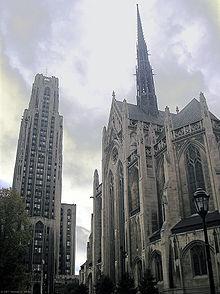
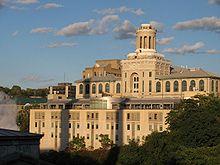
The City of Pittsburgh is home to many colleges, universities and research facilities, the most well-known of which are Carnegie Mellon University, Duquesne University, and the University of Pittsburgh. Also located in the city are Carlow University, Chatham University, Point Park University, The Art Institute of Pittsburgh, and a branch campus of suburban Robert Morris University as well as the Community College of Allegheny County, The Pennsylvania Culinary Institute, and the Pittsburgh Institute of Mortuary Science. The greater Pittsburgh region boasts even more colleges and universities, including Clarion University of Pennsylvania, LaRoche College, Slippery Rock University, Westminster College and Grove City College north of the city, Robert Morris University and Geneva College west of the city, Washington & Jefferson College, California University of Pennsylvania and Waynesburg University to the south, and Seton Hill University, Saint Vincent College and Indiana University of Pennsylvania ae the biggest state university ae to the east.
The campuses of Carlow University, Carnegie Mellon University, and the University of Pittsburgh are located adjacent to each other in the Oakland neighborhood that is the traditional cultural and education center of the city. Carnegie Mellon University (CMU) is a private research university founded by Andrew Carnegie and is ranked No. 22 overall on US News & World Report list of America's Best National Universities.[162] Carnegie Mellon is globally respected for its computer science, engineering, business, economics, public policy, information systems, fine arts, behavioral decision making, entrepreneurship, and psychology programs. The University of Pittsburgh, established in 1787 and popularly referred to as "Pitt", is a state-related school with one of the country's largest research programs.[163][164] Pitt is ranked as the 19th national public university by US News & World Report and 57th overall, and is known for its programs in philosophy, international studies, information science, engineering, business, law, medicine, and other biomedical and health-related sciences.[162][165][166][167][168] Carlow University is a small private Roman Catholic university that while coeducational, has traditionally educated women. Chatham University, a liberal arts women's college with coeducational graduate programs, is located in the nearby Shadyside neighborhood, but also maintains a 400-acre (1.6 km2) Eden Hall Farm campus located in the North Hills. Duquesne University, a private Catholic university, is located in the Bluff neighborhood of Pittsburgh and is noted for its song and dance company, the Tamburitzans, as well as programs in law, business, and pharmacy. Point Park University, which recently announced a major expansion of its downtown campus, is the youngest university in the city and well known for its Conservatory of Performing Arts and its operation of the Pittsburgh Playhouse. Robert Morris University is based in the suburb of Moon Township, Pennsylvania and maintains a satellite center in downtown Pittsburgh.
Pittsburgh Public Schools teachers are paid well relative to their peers, ranking 17th in 2000 among the 100 largest cities by population for the highest minimum salary offered to teachers with a BA ($34,300). Pittsburgh ranked fifth in the highest maximum salary offered to teachers with an MA ($66,380). Local public schools include many charter and magnet schools, including City Charter High School (computer and technology focused), Pittsburgh Montessori School (formerly Homewood Montessori), Pittsburgh Gifted Center, Barack Obama Academy of International Studies 6-12, Pittsburgh Creative and Performing Arts 6 ae12, Pittsburgh Science and Technology Academy, and a school for the blind, The Western Pennsylvania School for the Deaf, or otherwise challenged children.
Private schools in Pittsburgh include North Catholic High School, Bishop Canevin High School, Seton-La Salle Catholic High School, Central Catholic High School, Oakland Catholic High School, Winchester Thurston School, St. Edmund's Academy, and The Ellis School. Shady Side Academy maintains a PK ae5 primary school campus in the Point Breeze neighborhood, in addition to its 6 ae12 middle and upper school campuses located in nearby suburban Fox Chapel.
The city also has an extensive library system, both public and university. Most notable are the Carnegie Library of Pittsburgh and the University of Pittsburgh's University Library System, which rank 9th largest (public) and 18th largest (academic) in the nation, respectively.[169]
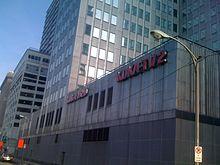
There are two major daily newspapers in Pittsburgh: the Pittsburgh Post-Gazette and the Pittsburgh Tribune-Review. Alternative weekly papers in the region include the Pittsburgh City Paper, Pittsburgh Catholic, The Jewish Chronicle of Pittsburgh, The New People, and the New Pittsburgh Courier. Independent student-written university-based newspapers include The Pitt News of the University of Pittsburgh, The Tartan of Carnegie Mellon University, "The Duquesne Duke" of "Duquesne University", and The Globe of Point Park University. University of Pittsburgh School of Law is also home to JURIST, the world's only university-based legal news service.
The Pittsburgh metro area is served by many local television and radio stations. The Pittsburgh designated market area (DMA) is the 22nd largest in the U.S. with 1,163,150 homes (1.045% of the total U.S.).[170] The major network television affiliates are KDKA-TV 2 (CBS), WTAE 4 (ABC), WPXI 11 (NBC), WPGH-TV 53 (Fox), WPCW 19 (CW), WINP-TV 16 (Ion), WPMY 22 (MyNetworkTV), and WPCB 40 (Cornerstone). WBGN-LD 16 is an independent station owned and operated by the Bruno-Goodworth Network.
WQED 13 is the local PBS station in Pittsburgh. It was established on April 1, 1954, and was the first community-sponsored television station and the fifth public station in the United States. The station has produced much original content for PBS, including Mr. Rogers' Neighborhood, several National Geographic specials, and Where in the World is Carmen Sandiego?[171]
There are a wide variety of radio stations serving the Pittsburgh market. The first was KDKA 1020 AM, also the world's first commercially licensed radio station, airing on November 2, 1920.[172] Other popular stations include KQV 1410 AM (news), WBGG 970 AM (sports), KDKA-FM 93.7 FM (sports), WKST-FM 96.1 FM (pop and hip-hop), WAMO-AM 660 AM (pop and hip-hop) WBZZ 100.7 FM ( Hot Adult Contemporary), WDVE 102.5 FM (album rock), WPGB 104.7 FM (talk), and WXDX 105.9 FM (modern rock). There are also three public radio stations in the area; including WESA 90.5 FM (National Public Radio affiliate and jazz music station operated by Duquesne University), WQED 89.3 FM (classical), and WYEP 91.3 FM (adult alternative). Three non-commercial stations are run by Carnegie Mellon University (WRCT 88.3 FM), the University of Pittsburgh (WPTS 92.1 FM), and Point Park University (WPPJ 670 AM).
Following the passage of the Pennsylvania Film Production Tax Credit in 2006, activity in Pittsburgh's film industry rapidly accelerated, further diversifying the city and regional economy.[173] According to the Pittsburgh Film Office, over 123 major motion pictures have been filmed, in whole or in part, in Pittsburgh, including The Mothman Prophecies, Wonder Boys, Dogma, Hoffa, The Silence of the Lambs, and Zack and Miri Make a Porno. Pittsburgh became "Gotham City" in 2011 during filming of The Dark Knight Rises.[174][175] Horror director George A. Romero, a Pittsburgh native, has shot nearly all of his films in and around Pittsburgh, including the majority of his Living Dead series. Showtime's popular series Queer as Folk is also set in Pittsburgh, although actual filming is done in Toronto.[176]
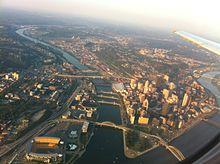
Pittsburgh is a city of bridges with a total of 446. Pittsburgh has three bridges more than Venice, Italy, which has historically held the title "City of Bridges."[177] Around 40 bridges cross the three rivers near the city. The southern "entrance" to Downtown is through the Fort Pitt Tunnel and over the Fort Pitt Bridge. The Panhandle Bridge carries the Port Authority's Blue/Red/Brown subway lines across the Monongahela River. Over 2,000 bridges span the landscape of Allegheny County.[178]
Expressways
Other Highways
Locals refer to the interstates fanning out from downtown Pittsburgh as the "parkways." I-376 is both the "parkway east" connecting to I-76 (Pennsylvania Turnpike) and the "parkway west" connecting to I-79, the Pittsburgh International Airport, the Ohio end of the Turnpike and I-80. The "parkway north" is I-279 connecting to I-79. The "crosstown" is I-579 allowing access to the heart of downtown, the Liberty Tunnels and the CONSOL Energy Center. Expressways such as Route 28 and Route 22 also carry traffic from downtown to the northeast and western suburbs, respectively. I-70, I-79 and I-76 (the Turnpike) roughly form a triangular-shaped "beltway" with I-80 and I-68 within the city's media market's northern and southern boundaries. Several suburban Turnpike spurs along the Monongahela River, the Airport and near Greensburg also help traffic flow. Navigation around the city and its suburbs can also be accomplished via the non-expressway Pittsburgh/Allegheny County Belt System.
A planned highway system called the Mon-Fayette/Southern Beltway project would allow access from the south and southwest of the city via a limited-access tolled expressway system.[179] The projects are in the planning stages with some sections already open to traffic. The projects are being planned by The Pennsylvania Turnpike Commission.[180]
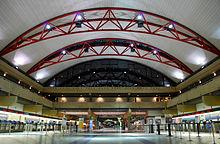
The city is served by Pittsburgh International Airport (IATA: PIT) 17 miles (27 km) to the west in Findlay Township.[181] The airport was the longtime major hub for US Airways from the company's start in the 1940s until the mid 2000s. In 2000, US Airways and its regional affiliates operated over 500 daily departures from Pittsburgh to more than 110 destinations; by 2007 fewer than 70 departures to 21 destinations remained.[182] However, in 2007, US Airways chose the city to house its new $25 million, 27,000 sq ft (2,500 m2), 600-employees-strong Global Flight Operations Center, consolidating its two smaller (pre-merger) centers in Phoenix, Arizona and along I-376 in metro Pittsburgh. Currently, the largest promotions at the airport is the expansion of other airlines, particularly Delta Air Lines' new direct trans-Atlantic service to Paris as well as JetBlue and Southwest Airlines rapid expansion at the complex.
Art deco style Allegheny County Airport (AGC) handles 139,000 general aviation flights a year, and is located south of the city in West Mifflin. There are also smaller airports located near the city used primarily for corporate jets and other private aircraft: Rock Airport is northeast of Pittsburgh near the borough of Tarentum and Pittsburgh-Monroeville Airport is east of the city in Monroeville.
Commercial service is also available at suburban Arnold Palmer Regional Airport in the borough of Latrobe via Spirit Airlines and formerly Delta Air Lines and US Airways commuter service.
Several suburban private plane bases serve the region, the largest of these include Rostraver Airport and Pittsburgh-Monroeville Airport.
Port Authority of Allegheny County, commonly known as the Port Authority, but sometimes referred to by its former nickname "PAT" or "PAT Transit", is the region's mass transit system. While serving only a portion of the Pittsburgh area's 20th largest metro area, it is the 11th largest transit agency in the nation. Port Authority runs a network of intracity and intercity bus routes, the Monongahela Incline funicular railway (more commonly known as an "incline") on Mount Washington, a light rail system that runs mostly above-ground in the suburbs and underground as a subway in the city, and one of the nation's largest busway systems.[183] The Duquesne Incline is operated by a non-profit preservation trust,[184] but it does accept Port Authority passes and charge standard Port Authority tolls.
The city has Amtrak intercity rail service via the Capitol Limited and the Pennsylvanian at Pennsylvania Station, also known as Union Station. Current freight railroads include CSX and Norfolk Southern. Enhancements to allow for highspeed rail transit connections to Philadelphia and the Northeast Corridor are underway as part of the American Recovery and Reinvestment Act of 2009.
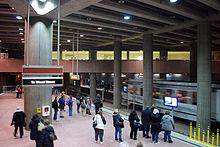
Between 2007 and 2010, the Port Authority cut its annual expenses by $52 million and raised its revenues by $14 million to help alleviate a statewide transportation funding crisis.[185] The funding crisis only grew worse, however. The state legislature assumed it would receive permission to convert Interstate 80 into a toll road to increase revenues, but the federal government denied the request, leading to a gap in the state transportation budget of $472 million.[186]
On November 24, 2010, the Port Authority's board of directors approved a massive service cut and fare hike to go into effect in March 2011. The service cut would reduce total service hours by approximately 35 percent, including the elimination of 45 routes.[185] The Port Authority's budget from the state is to be substantially reduced for 2011, and as chairperson Joan Ellenbogen noted, the Port Authority is legally required to adopt a balanced budget.[187] Chairperson Guy Mattola stated that "Unfortunately, we are now at the point that all options have been exhausted ... It is necessary to move forward with this service reduction plan recognizing the devastating consequences for riders and non-riders alike."[188]
On December 13, 2010, the Southwestern Pennsylvania Commission approved a plan by Governor Ed Rendell to allocate $45 million in temporary funding for the Port Authority to help reduce the magnitude of these service cuts.[189] Ultimately, service was cut 15 percent effective March 27, 2011.[190]
Last year at inauguration Corbett took office with the desire to "unleash a new common prosperity to benefit all Pennsylavnians" and his second plan was $27.1 billion for the year 2012-2013 with deep funding cuts and cold shoulder toward new revenues.[191] The Port Authority said it plans to cut service by 35% if it does not receive help with a porjected $64 million budget deficit. The transit riders, community advocates, and legislative leaders from both parties have called for action on transportation funding. Corbett then gave a speech saying that transportation funding "is not a budget item.[192]
The city is served by Duquesne Light, one of the original power companies founded in 1912 by George Westinghouse. Water utility service is provided by the Pittsburgh Water and Sewer Authority[193] and Pennsylvania American Water.
Natural gas is widely used in the area due to large reserves existing in the region. Service in Pittsburgh is provided by Equitable Gas and Columbia Gas. Both companies offer "Customer Choice" programs in which residents may choose alternative natural gas suppliers who work under an agreement to provide natural gas in smaller service areas; these companies include Dominion Peoples Plus, Direct Energy Services LLC, and Novec Energy Solutions.
The two largest health care providers are the University of Pittsburgh Medical Center and West Penn Allegheny Health System, respectively.
Pittsburgh has twenty four sister cities:[194][195][196]
 North America portal
North America portal
Word Count: 13473





